Do you have a question about the Pentair MasterTemp 175 and is the answer not in the manual?
Explains the heater identification system: model size, fuel type, and construction.
Key safety instructions to read and follow before operating the heater.
Notices regarding warranty and proper installation for safety.
Details about the limited factory warranty and how to register the product.
Compliance requirements for installation based on national and local codes.
Safety warnings and guidelines for pool/spa water temperature and user precautions.
Key specifications including clearances, certifications, and intended use of the heater.
Overview of the heater's components and operation sequence.
Detailed explanation of the heater's operational steps and safety interlocks.
Initial steps and checks before operating the heater for the first time.
Physical dimensions and installation requirements for the heater.
Instructions and diagrams for connecting the heater to the pool/spa plumbing system.
Guidelines for proper water flow, pressure, and connection types.
Placement and use of valves in the circulation system for isolation and back-siphoning prevention.
Instructions for installing and adjusting a manual by-pass valve for flow rates.
Specific instructions for adjusting pressure switches when the heater is below pool level.
Requirements for installing a flow switch when the heater is significantly above or below pool level.
Instructions for connecting the gas supply to the heater.
Guidance on selecting gas pipe sizes based on distance and gas type.
Requirements for installing sediment traps in the gas piping system.
Table providing maximum equivalent pipe lengths for gas line connections.
Procedures for leak testing gas connections and checking gas pressure.
Instructions for qualified technicians to check gas pressure at the control valve.
Table specifying required gas pressure values for Natural and Propane gas.
General guidelines for outdoor installations and warnings about propane gas.
Required clearances from combustible surfaces for outdoor installations.
Diagrams and requirements for outdoor vent termination and clearances.
Requirements for Category I and Category III venting systems for indoor installations.
Required clearances from combustible surfaces for indoor installations.
Instructions for removing the outside vent cover for specific installations.
Requirements for air supply openings for proper combustion and ventilation indoors.
Guidelines for using a PVC duct for combustion air intake in indoor installations.
Identifies areas and contaminants that can cause corrosive damage to the heater.
General requirements for indoor venting, including Type 'B' connectors.
Detailed instructions for vertical venting in negative pressure systems.
Instructions for Category III venting, using special gas approved vent pipes.
Steps for connecting special metallic gas vents to the heater, including adapter kits.
Requirements for horizontal vent termination locations in the U.S. and Canada.
Specific installation guidelines and warnings for garages or utility rooms.
Instructions for rotating the control panel for optimal access and orientation.
Checklist of critical items to verify before final operation of the heater.
Detailed instructions for making electrical connections, including voltage selection.
Instructions for connecting 2-wire or 3-wire external control systems or timers.
Wiring diagram illustrating the electrical connections for a 3-wire system.
Schematic ladder diagram showing the heater's electrical logic and components.
Fundamental steps for basic operation, including pump and power activation.
Instructions for starting up and shutting down the heater.
Key checks and procedures to perform before the initial start-up.
Pre-operation checks, including smelling for gas and checking controls.
Emergency procedures to follow if a gas leak is detected.
Step-by-step guide on how to operate the heater and set temperatures.
Procedure for safely shutting off the gas supply to the heater.
Explanation of safety devices like the Air Flow Switch and Water Pressure Switch.
Details the function and operation of the Air Flow Switch.
Information on the water pressure switch, its settings, and adjustment.
Explanation of the High Limit safety devices that prevent overheating.
Description of the microprocessor-based ignition module and its function.
Explanation of the control panel buttons, display, and indicator lights.
How to set the desired pool and spa temperatures using the control panel.
Procedure to set the maximum temperature limits for pool and spa.
Preliminary steps and checks before beginning detailed troubleshooting.
Troubleshooting chart for heater not firing, starting with basic checks.
Troubleshooting chart for heater not firing, focusing on service system and flow issues.
Troubleshooting chart for heater not firing, checking ignition module and gas valve.
Troubleshooting chart for heater not firing, focusing on igniter and gas pressure.
Guide to interpreting diagnostic LED codes for various safety switches.
Troubleshooting steps for the Stack Flue Sensor (SFS) diagnostic LED.
Common burner symptoms and their causes and remedies.
Common issues with the heat exchanger, their causes, and remedies.
Recommended routine maintenance tasks for the heater.
Instructions for installing and testing a pressure relief valve if required.
Checks to perform after the initial heater start-up.
How to check for adequate water flow through the heater.
Recommendations for seasonal operation of the heater.
Instructions and precautions for winterizing the heater.
Tips for maintaining consistent pool and spa temperatures.
Advice on how to reduce heating costs and conserve energy.
Importance of maintaining proper water chemistry for heater longevity.
Guidance on water chemistry practices for pool and spa heating.
Explanation of the role of disinfectants in pool water sanitation.
Definition and importance of maintaining disinfectant residual levels.
Explanation of pH and its ideal range for pool water chemistry.
Explanation of total alkalinity and its importance for pH control.
Explains the heater identification system: model size, fuel type, and construction.
Key safety instructions to read and follow before operating the heater.
Notices regarding warranty and proper installation for safety.
Details about the limited factory warranty and how to register the product.
Compliance requirements for installation based on national and local codes.
Safety warnings and guidelines for pool/spa water temperature and user precautions.
Key specifications including clearances, certifications, and intended use of the heater.
Overview of the heater's components and operation sequence.
Detailed explanation of the heater's operational steps and safety interlocks.
Initial steps and checks before operating the heater for the first time.
Physical dimensions and installation requirements for the heater.
Instructions and diagrams for connecting the heater to the pool/spa plumbing system.
Guidelines for proper water flow, pressure, and connection types.
Placement and use of valves in the circulation system for isolation and back-siphoning prevention.
Instructions for installing and adjusting a manual by-pass valve for flow rates.
Specific instructions for adjusting pressure switches when the heater is below pool level.
Requirements for installing a flow switch when the heater is significantly above or below pool level.
Instructions for connecting the gas supply to the heater.
Guidance on selecting gas pipe sizes based on distance and gas type.
Requirements for installing sediment traps in the gas piping system.
Table providing maximum equivalent pipe lengths for gas line connections.
Procedures for leak testing gas connections and checking gas pressure.
Instructions for qualified technicians to check gas pressure at the control valve.
Table specifying required gas pressure values for Natural and Propane gas.
General guidelines for outdoor installations and warnings about propane gas.
Required clearances from combustible surfaces for outdoor installations.
Diagrams and requirements for outdoor vent termination and clearances.
Requirements for Category I and Category III venting systems for indoor installations.
Required clearances from combustible surfaces for indoor installations.
Instructions for removing the outside vent cover for specific installations.
Requirements for air supply openings for proper combustion and ventilation indoors.
Guidelines for using a PVC duct for combustion air intake in indoor installations.
Identifies areas and contaminants that can cause corrosive damage to the heater.
General requirements for indoor venting, including Type 'B' connectors.
Detailed instructions for vertical venting in negative pressure systems.
Instructions for Category III venting, using special gas approved vent pipes.
Steps for connecting special metallic gas vents to the heater, including adapter kits.
Requirements for horizontal vent termination locations in the U.S. and Canada.
Specific installation guidelines and warnings for garages or utility rooms.
Instructions for rotating the control panel for optimal access and orientation.
Checklist of critical items to verify before final operation of the heater.
Detailed instructions for making electrical connections, including voltage selection.
Instructions for connecting 2-wire or 3-wire external control systems or timers.
Wiring diagram illustrating the electrical connections for a 3-wire system.
Schematic ladder diagram showing the heater's electrical logic and components.
Fundamental steps for basic operation, including pump and power activation.
Instructions for starting up and shutting down the heater.
Key checks and procedures to perform before the initial start-up.
Pre-operation checks, including smelling for gas and checking controls.
Emergency procedures to follow if a gas leak is detected.
Step-by-step guide on how to operate the heater and set temperatures.
Procedure for safely shutting off the gas supply to the heater.
Explanation of safety devices like the Air Flow Switch and Water Pressure Switch.
Details the function and operation of the Air Flow Switch.
Information on the water pressure switch, its settings, and adjustment.
Explanation of the High Limit safety devices that prevent overheating.
Description of the microprocessor-based ignition module and its function.
Explanation of the control panel buttons, display, and indicator lights.
How to set the desired pool and spa temperatures using the control panel.
Procedure to set the maximum temperature limits for pool and spa.
Preliminary steps and checks before beginning detailed troubleshooting.
Troubleshooting chart for heater not firing, starting with basic checks.
Troubleshooting chart for heater not firing, focusing on service system and flow issues.
Troubleshooting chart for heater not firing, checking ignition module and gas valve.
Troubleshooting chart for heater not firing, focusing on igniter and gas pressure.
Guide to interpreting diagnostic LED codes for various safety switches.
Troubleshooting steps for the Stack Flue Sensor (SFS) diagnostic LED.
Common burner symptoms and their causes and remedies.
Common issues with the heat exchanger, their causes, and remedies.
Recommended routine maintenance tasks for the heater.
Instructions for installing and testing a pressure relief valve if required.
Checks to perform after the initial heater start-up.
How to check for adequate water flow through the heater.
Recommendations for seasonal operation of the heater.
Instructions and precautions for winterizing the heater.
Tips for maintaining consistent pool and spa temperatures.
Advice on how to reduce heating costs and conserve energy.
Importance of maintaining proper water chemistry for heater longevity.
Guidance on water chemistry practices for pool and spa heating.
Explanation of the role of disinfectants in pool water sanitation.
Definition and importance of maintaining disinfectant residual levels.
Explanation of pH and its ideal range for pool water chemistry.
Explanation of total alkalinity and its importance for pH control.
| Model | MasterTemp 175 |
|---|---|
| Category | Swimming Pool Heater |
| Heating Capacity | 175, 000 BTU/hr |
| Fuel Type | Natural Gas or Propane |
| Heat Exchanger Material | Copper |
| Efficiency | 82% |
| Minimum Water Flow | 20 GPM |
| Maximum Working Pressure | 50 PSI |
| Voltage | 120V |
| Ignition Type | Electronic |
| Warranty | 1 Year |
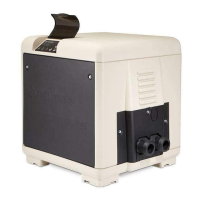
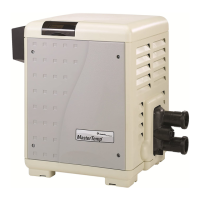
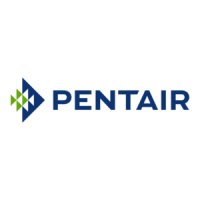
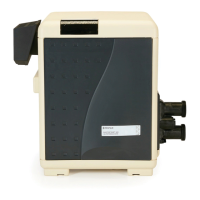


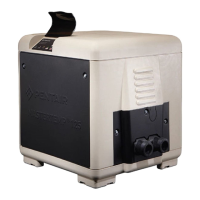
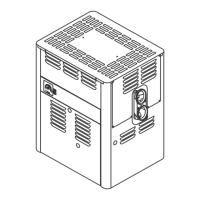

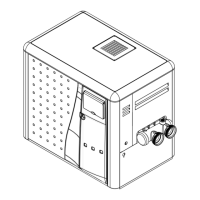
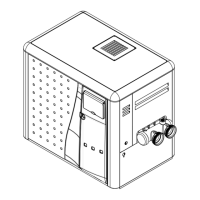
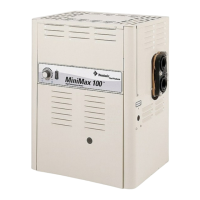
